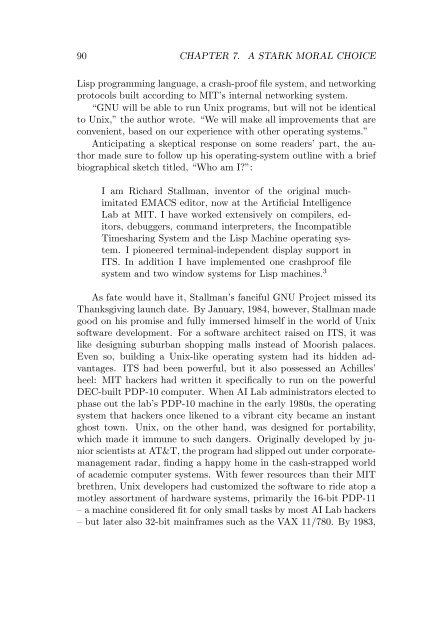You also want an ePaper? Increase the reach of your titles
YUMPU automatically turns print PDFs into web optimized ePapers that Google loves.
90 CHAPTER 7. A STARK MORAL CHOICE<br />
Lisp programming language, a crash-proof file system, and networking<br />
protocols built according to MIT’s internal networking system.<br />
“GNU will be able to run Unix programs, but will not be identical<br />
to Unix,” the author wrote. “We will make all improvements that are<br />
convenient, based on our experience with other operating systems.”<br />
Anticipating a skeptical response on some readers’ part, the author<br />
made sure to follow up his operating-system outline with a brief<br />
biographical sketch titled, “Who am I?”:<br />
I am Richard Stallman, inventor of the original muchimitated<br />
EMACS editor, now at the Artificial Intelligence<br />
Lab at MIT. I have worked extensively on compilers, editors,<br />
debuggers, command interpreters, the Incompatible<br />
Timesharing System and the Lisp Machine operating system.<br />
I pioneered terminal-independent display support in<br />
ITS. In addition I have implemented one crashproof file<br />
system and two window systems for Lisp machines. 3<br />
As fate would have it, Stallman’s fanciful GNU Project missed its<br />
Thanksgiving launch date. By January, 1984, however, Stallman made<br />
good on his promise and fully immersed himself in the world of Unix<br />
software development. For a software architect raised on ITS, it was<br />
like designing suburban shopping malls instead of Moorish palaces.<br />
Even so, building a Unix-like operating system had its hidden advantages.<br />
ITS had been powerful, but it also possessed an Achilles’<br />
heel: MIT hackers had written it specifically to run on the powerful<br />
DEC-built PDP-10 computer. When AI Lab administrators elected to<br />
phase out the lab’s PDP-10 machine in the early 1980s, the operating<br />
system that hackers once likened to a vibrant city became an instant<br />
ghost town. Unix, on the other hand, was designed for portability,<br />
which made it immune to such dangers. Originally developed by junior<br />
scientists at AT&T, the program had slipped out under corporatemanagement<br />
radar, finding a happy home in the cash-strapped world<br />
of academic computer systems. With fewer resources than their MIT<br />
brethren, Unix developers had customized the software to ride atop a<br />
motley assortment of hardware systems, primarily the 16-bit PDP-11<br />
– a machine considered fit for only small tasks by most AI Lab hackers<br />
– but later also 32-bit mainframes such as the VAX 11/780. By 1983,


